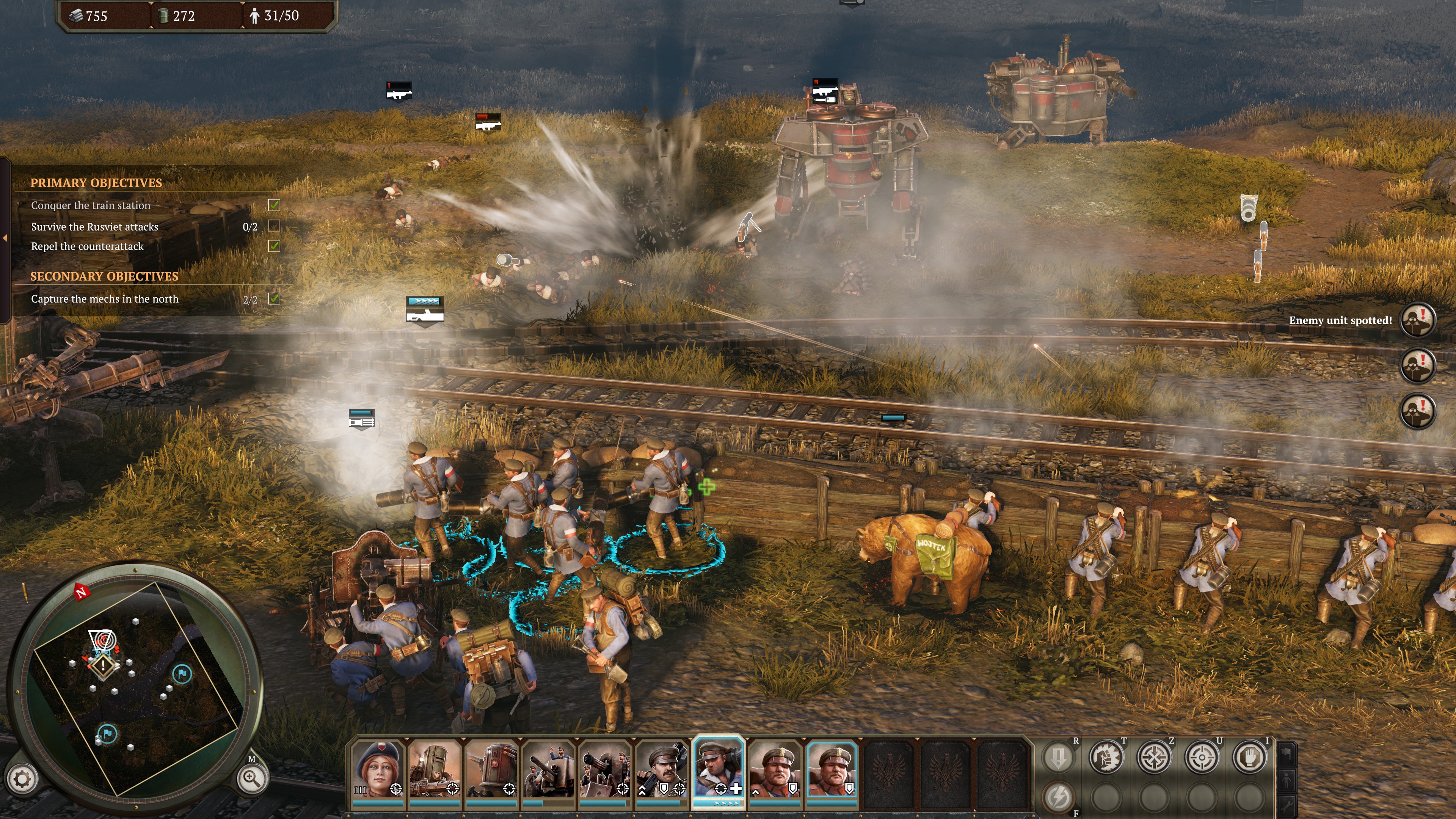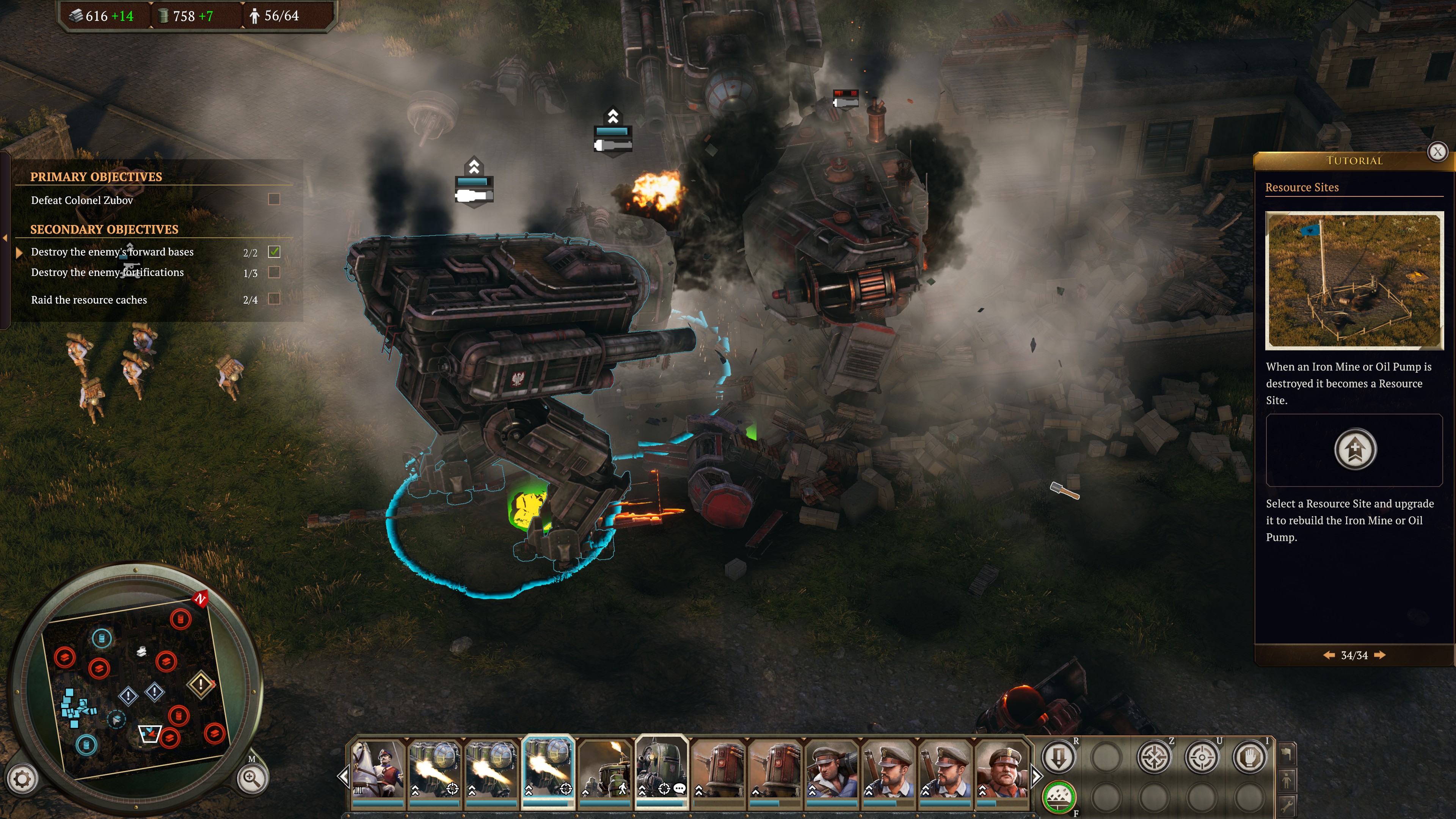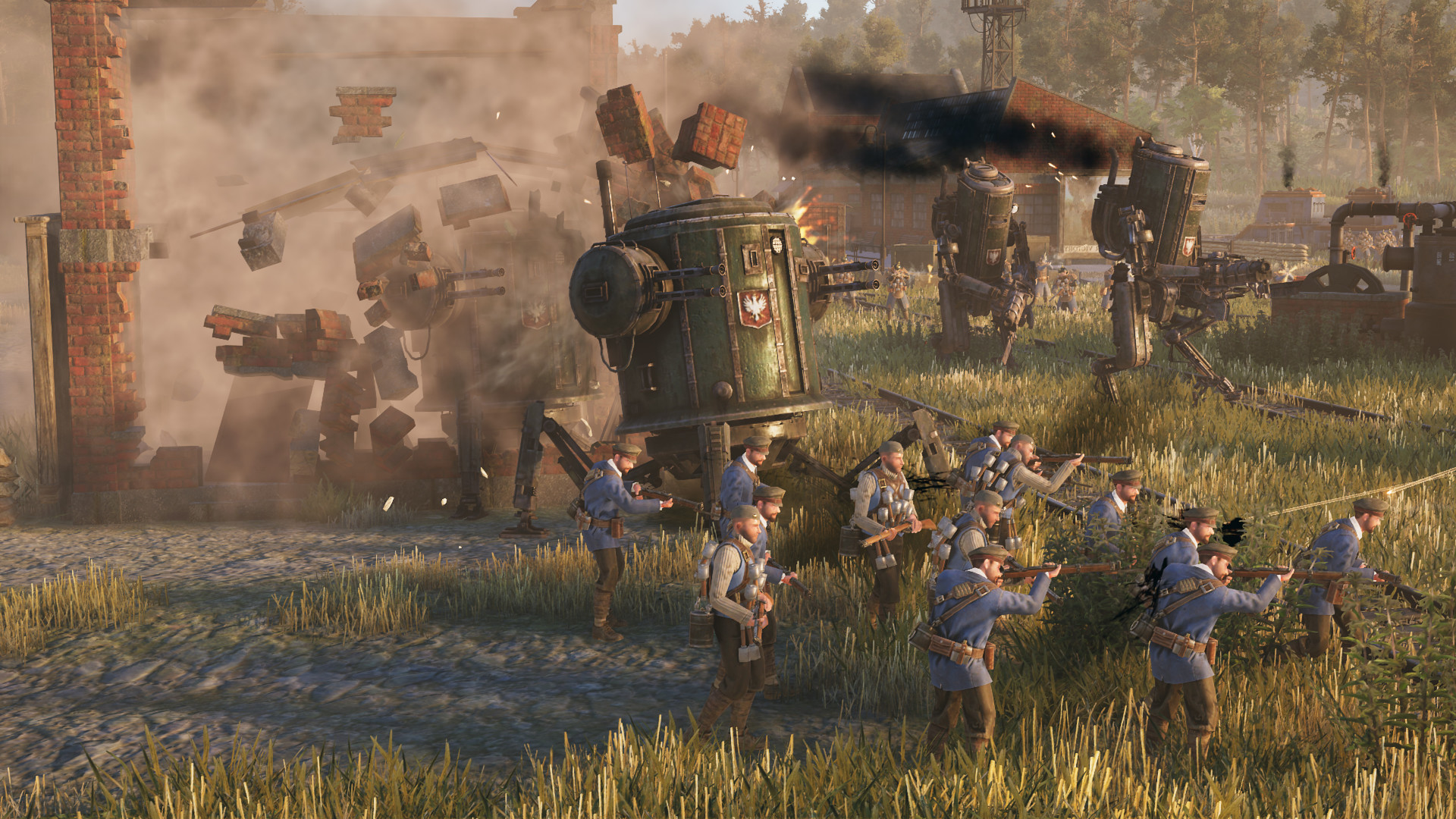Our Verdict
Iron Harvest's mech-based strategy can burn a little slow, but the payoff is undoubtedly worth it.
PC Gamer's got your back
What is it? Mech-tacular RTS with strong whiffs of Company of Heroes.
Expect to pay: $50/£47
Developer: KING Art
Publisher: Deep Silver
Reviewed on: Nvidia GeForce 2080 Super, AMD Ryzen 5 3600, 32 GB Ram
Out: September 1
Multiplayer? Yes
Link Official site
Iron Harvest is a thirty-hour exercise in self one-upmanship. Oh! You think a crack sniper lady with a pet bear is cool, do you? Then how about a walking oil-drum armed with twin heavy-machine-guns? So you think that's cool eh? Then how about a quadrupedal personnel-carrier that fires mortars out of its roof? OH! You think THAT'S cool, bucko? Then how about a goddamn BATTLE TRAIN? Yeah, you heard me. Battle. Train.
The game's approach to entertainment is an avalanche of awe, burying your cynicism in a scrapheap of increasingly powerful toys that'll have you grinning like a certain cat from a certain English county. It makes itself hard to dislike, even with a story that's clumsily written and an underlying strategy engine that needs more oil in its gears.
Iron Harvest graduates from the Relic school of real-time-strategy circa 2006. A standard match sees you battling over resource-generating control points dotted around the map with the ultimate goal of destroying the enemy headquarters. Base-building and maintenance is streamlined to require minimal attention, such that the game can focus almost entirely on combat and conquest.

The basic formula sticks close to that established in Company of Heroes, but there is one crucial difference—the setting. Iron Harvest takes place in an alternate 1920s conceived by Polish artist Jakub Różalski and previously used for the critically acclaimed boardgame Scythe. Its story revolves around three factions that emerged from Iron Harvest's version of World War One, namely Saxony, Rusvia, and Polania (no prizes for guessing the inspirations there). Iron Harvest focuses on the war's aftermath, where a fragile truce between Saxony and Rusvia threatens to collapse under the pressure of a shadowy cabal of malicious instigators.
In this world, Tsar Nicholas II is still alive, as is his best pal Rasputin. The 1917 revolution never happened, and rather than becoming an independent state at the end of the war, Polania is subject to Rusvian rule. There's one other tiny difference too—mechs. Towering, diesel-powered combat walkers armed to the teeth with World War 1 era weaponry. Machineguns, flamethrowers, artillery, Iron Harvest takes the appalling armaments of the Great War and gives it legs.
The detail lent to these gigantic war machines is delightful, particularly the animation.
The mechs are undoubtedly Iron Harvest's main draw, so it's to the developer's credit that they are so rewarding to command. The designs are phenomenal, ranging from the Polanian Smialy, a sort of weaponised boiler that carries a massive bolt-action rifle, to the nigh-unstoppable Rusvian Gulay-Gorod, an enormous bipedal artillery platform that can destroy entire buildings simply by walking through them. The detail lent to these gigantic war machines is delightful, particularly the animation. Iron Harvest's mechs are lumbering, stumbling creations with thrumming diesel engines that cause the whole machine to oscillate, as if constantly on the verge of collapsing or exploding. They seem to defy physics with every moment of their existence, and this makes them thrilling to watch in motion.

As for combat, good grief. The spectacle of any given Iron Harvest match is phenomenal. Matches start out small, with squads of rifleman trading potshots from cover as they rush to capture early control points. Then it layers in more advanced types of infantry—grenadiers who can destroy cover and cripple units with a well-placed grenade, and machine-gunners who can pin enemy units down and create chokepoints on the map. Shortly afterward, the mechs begin to appear, mainly anti-infantry at first, but soon combat is mech on mech, giant death machines trading massive cannon shots that leave whole sectors scarred with craters and reduce buildings to rubble. The sound of Iron Harvest in full swing is tremendous. I can't decide if the audio designers deserve a medal or a reprimand for creating such a cacophonous hellscape.
Iron Harvest loves playing with scale, and that goes for its campaign as much as individual matches. Although they seamlessly conjoin into one story, there are actually three campaigns, each focussing on a different faction. The Polanian campaign, for example, charts the story of the country's resistance against Rusviet occupation, as young resistance fighter Anna Kos tries to rescue her father from the evil general Zubov. It's a surprisingly cinematic experience too, with missions bookended by meticulously directed cutscenes telling the story of the three-way conflict. It's an impressive endeavour filled with twists and turns that elevate it beyond a straightforward war story, although stock characters and a whiff of cheese about the script hamper its narrative aspirations.
In play, the campaign intersperses familiar RTS skirmishes with more character focussed missions, with each gradually building up your unit roster from lone infantry to your full combined forces. Sometimes they blend the two. One of its more unique examples sees you trying to protect a train filled with supplies as it weaves its way through a Polanian valley, while an early Rusviet mission involves sneaking through St Petersburg, joining up with scattered Rusviet forces as you gradually work your way toward the Winter Palace. The variety imbued in the campaign does result in some weaker scenarios, however. One mission in the middle of the Rusviet campaign includes insta-fail stealth, which is exceptionally frustrating.

There are other problems too. At infantry level, Iron Harvest employs a cover system much like Company of heroes, with green circles highlighting when your character can hide behind walls. But the system is spotty about what counts as cover, while the maps aren't really built to engender fire and move mechanics. Compounding this is that, when caught out of cover, AI infantry tends to run directly into your line rather than retreat to a defensive position, which can make infantry encounters scrappy and unsatisfying.
The game's main feature, those massive, city-destroying mechs are arguably the source of Iron Harvest's biggest problem.
It's a shame the cover-system is a little haphazard because otherwise Iron Harvest's early to mid game has plenty of tactical nuance. Alongside anti-infantry mechs, there are anti-mech infantry who pulverise armour with massive cannons. Flame units of all stripes will absolutely annihilate infantry, but are much less effective against mechs. Mechs also take more damage when shot in the rear, encouraging you to flank them or to use infantry to toss explosives behind them.
Defensive structures like bunkers are extremely useful for stopping your opponent harassing your base with infantry and smaller mechs, while keeping a group of engineers with your mechs enables them to perform repairs in the field and keep them in the fight longer. Lastly, infantry retains a key role when the bigger mechs roll-out. Only infantry can capture control points, and can also harvest resources from destroyed mechs (both yours and the opponents) enabling you to field new units more quickly.

All this works well at a smaller scale, but the game's main feature, those massive, city-destroying mechs are arguably the source of Iron Harvest's biggest problem. Larger mechs are so slow and so powerful that tactics tend to go out the window when they get involved, so fights mainly come down to whoever's got the biggest gun. Their sluggish speed also slows the late game down to a crawl. It can take a larger mech five to ten minutes to cross the map, so long that the situation has often changed when it arrives at its destination. If that mech fails in its objective and is destroyed, you then have to go through the whole rigmarole again.
It's worth noting that the factions are well-balanced, and battles are rarely one-sided affairs. But this attritional warfare combined with slow-moving units means matches can drag on incessantly, less build 'n' rush and more build 'n' plod.
I'm not saying Iron Harvest should be Starcraft. I don't expect a diesel-powered WW1 era mech to move like a gazelle. But it would benefit from making everything resolve a little quicker, reducing the downtime of collecting resources on the map and manoeuvring mechs into position. All that said, Iron Harvest is still a spectacular and rock-solid RTS—a worthy spiritual successor to one of the best RTS games ever made.
Iron Harvest's mech-based strategy can burn a little slow, but the payoff is undoubtedly worth it.
Rick has been fascinated by PC gaming since he was seven years old, when he used to sneak into his dad's home office for covert sessions of Doom. He grew up on a diet of similarly unsuitable games, with favourites including Quake, Thief, Half-Life and Deus Ex. Between 2013 and 2022, Rick was games editor of Custom PC magazine and associated website bit-tech.net. But he's always kept one foot in freelance games journalism, writing for publications like Edge, Eurogamer, the Guardian and, naturally, PC Gamer. While he'll play anything that can be controlled with a keyboard and mouse, he has a particular passion for first-person shooters and immersive sims.


